Preparation, Physicochemical Properties, and Hemocompatibility of the Composites Based on Biodegradable Poly(Ether-Ester-Urethane) and Phosphorylcholine-Containing Copolymer
Round 1
Reviewer 1 Report
In this manuscript, the composites of PEEU and MPC-copolymer were prepared by simple physical blending to improve the hemocompatibility of PU materials. The effect of the MPC copolymer introduced in the PEEU films on the physicochemical properties of PEEU was investigated. Due to the biodegradability, satisfied tensile properties and good surface hemocompatibility, the composites can be expected to be applied in blood-contacting devices. This work has certain innovation. However, the authors did not perform adequate experiments to prove the applications of their materials. It is my assessment that this manuscript must be qualified with stronger experimental data. And here is some problems as follow:
At the beginning of the discussion, the author had better draw a schematic diagram, so that the reader can understand the content of this study more quickly. And some photos of the films should also be added.
In addition to good hemocompatibility, the author's description of the relation between the characteristics of the material and blood-contacting devices is not enough to convince me that it can be a better choice.
Some abbreviations, when used for the first time, should be used in full. e.g. BSA (page 5, line 203),
In page 10, line 344, the author said that the surface hemocompatibility will be further evaluated by using human whole blood, so why not show it here? In fact, I think the authors must do more testing ( e.g. some in vivo test ) to confirm their material's potential use as a blood-contacting devices.
In the degradation experiment, we saw that the PMPU-20 did not achieve data presentation after about 12 days. Was it all degraded? I don’t think so, and PMPU-0 showed the lowest degradation rate and pmpu-20 the highest at finally. Is the more degradation quality of PMPU-20 than that of PMPU-0 from PMEH? The author had better analyze the degraded components and confirm that the addition of PHEM can also promote the degradation of PEEU.
Some other related work might be cited and discussed to improve their manuscript. For example: Nature communications, 2018, 9, 2784; Chemical Engineering Journal, 2019, 366, 208-222; Small, 2019, 15, 1900046; Biomaterials, 2018, 183, 185-199; Chemistry of Materials, 2015, 27 (16), 5668.
Author Response
Please see the attached file.
Author Response File: ![]() Author Response.pdf
Author Response.pdf
Reviewer 2 Report
This paper reports the blending of biodegradable polyurethane and polyacrylate containing phosphorylcholine group, and thermal/tensile/degradation/hemocompatibility properties. The reviewer thinks that some revisions are requested before the publication in Polymers.
1. The reviewer suggests that the introduction part emphasize the distinction of the blending method from previous reports dealing PU/phosphorylcholine.
2. The reviewer suggests to add a Scheme (Figure) for illustrating the preparation of PEEU, PMEH, and blends.
3. Line 238: The reviewer suggests to reconsider following sentence. “No other weight loss steps found in the curves of PMPU films indicated that the PMEH component was compatible with PEEU component” Is it because the content of PMEH is small, or decomposition temperature are similar range to PEEU? The authors should add TGA data of PMEH only.
4. Line 257: The authors can use this sentence, “resulting in high strain at break and a slight increase in ultimate stress”, after the authors provide error range of Table 2. The reviewer thinks that tensile data of PMPU-0 and PMPU-5 are within the error range.
5. Line 250: The reviewer disagree with the term “excellent tensile properties”. ~20 MPa is the general strength for plastics.
6. Line 257: The authors should not use “reinforcing fillers” without any observations of “fillers”.
7. Line 38: banckbone -> backbone
Author Response
Please see the attached file.
Author Response File: ![]() Author Response.pdf
Author Response.pdf
Round 2
Reviewer 1 Report
I am generally satisfied with the revisions, and I recommend the acceptance of this work.




